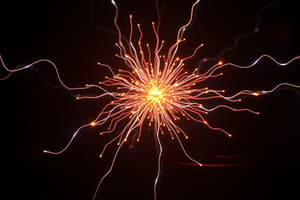Podcast
Questions and Answers
Who proposed the Earth's rotation?
Who proposed the Earth's rotation?
- René Descartes
- Thales of Miletus
- Aristotle
- Aryabhata (correct)
Who is considered the 'father of the modern scientific method'?
Who is considered the 'father of the modern scientific method'?
- Ibn al-Haytham (correct)
- Johannes Kepler
- Galileo Galilei
- Isaac Newton
Who developed the law of buoyancy and the principles of equilibrium states and centers of gravity?
Who developed the law of buoyancy and the principles of equilibrium states and centers of gravity?
- Archimedes of Syracuse (correct)
- Thales of Miletus
- Hipparchus
- Shen Kuo
Who built the first functioning reflecting telescope and developed a theory of color?
Who built the first functioning reflecting telescope and developed a theory of color?
Who identified the rings of Saturn and discovered the first of Saturn's moons, Titan?
Who identified the rings of Saturn and discovered the first of Saturn's moons, Titan?
What did the French Academy of Sciences dominate in the 18th century?
What did the French Academy of Sciences dominate in the 18th century?
Who formulated three laws of motion and the law of universal gravitation?
Who formulated three laws of motion and the law of universal gravitation?
What did the law of electromagnetic induction lead to?
What did the law of electromagnetic induction lead to?
What did the theory of general relativity propose?
What did the theory of general relativity propose?
Flashcards are hidden until you start studying
Study Notes
Historical Development of Physics
-
Physics is a branch of science that studies matter and energy.
-
Ancient physics drew from astronomy, optics, and mechanics, and was united through the study of geometry.
-
The rational understanding of nature began with the Pre-Socratic philosophers in Greece, such as Thales of Miletus, who proclaimed that every event had a natural cause.
-
Aristotle, a student of Plato, founded the system known as Aristotelian physics and attempted to explain ideas such as motion and gravity with the theory of four elements.
-
Archimedes of Syracuse was a leading scientist of classical antiquity who developed the law of buoyancy, the principles of equilibrium states and centers of gravity, and used the method of exhaustion to calculate the area under the arc of a parabola.
-
Hipparchus mapped the motion of the stars and planets and predicted the times that Solar eclipses would happen, while Ptolemy authored several scientific treatises, including the astronomical treatise known as the Almagest.
-
Ancient Indian philosophers developed a theory of atomism, while Aryabhata proposed the Earth's rotation and Nilakantha Somayaji proposed a semi-heliocentric model resembling the Tychonic system in astronomy.
-
Shen Kuo in ancient China described the magnetic-needle compass used for navigation and developed a camera obscura.
-
Scientific progress occurred in the Muslim world, and important contributions were made by Ibn al-Haytham, who is considered the "father of the modern scientific method" due to his emphasis on experimental data and reproducibility of its results, and Avicenna, who published his theory of motion in Book of Healing.
-
Awareness of ancient works re-entered the West through translations from Arabic to Latin, and Aristotelian physics became the foundation for medieval European scholars who sought to reconcile the philosophy of the ancient classical philosophers with Christian theology.
-
The scientific revolution of the 16th and 17th centuries marked a shift from Aristotelian physics to modern physics, with the work of scientists such as Galileo Galilei, Johannes Kepler, and Isaac Newton.
-
Modern physics includes the study of quantum mechanics, relativity, and particle physics, among other fields, and has led to applications in technology and other natural sciences.The Scientific Revolution: A Summary
-
Scholastic physics described things as moving according to their essential nature, with celestial objects moving in circles, and motion below the lunar sphere being seen as imperfect.
-
During the 16th and 17th centuries, the Scientific Revolution took place in Europe, with natural philosophers attacking the Scholastic philosophical programme.
-
Nicolaus Copernicus gave strong arguments for the heliocentric model of the Solar System, which was accepted as a revolutionary idea.
-
Galileo Galilei supported heliocentrism, made astronomical discoveries, and established experimentation as an integral part of natural philosophy.
-
René Descartes sought to replace the Scholastic philosophical tradition altogether, reducing all perceived phenomena to being attributable to the motion of an invisible sea of "corpuscles."
-
Christiaan Huygens was the leading scientist in Europe between Galileo and Newton, and his work in horology resulted in the invention of the pendulum clock.
-
Huygens' Horologium Oscillatorium is the first modern treatise in which a physical problem is idealized by a set of parameters then analyzed mathematically and constitutes one of the seminal works of applied mathematics.
-
Huygens' wave theory of light, initially rejected in favour of Newton's corpuscular theory, is now known as the Huygens–Fresnel principle.
-
Huygens was the first to identify the rings of Saturn and discover the first of Saturn's moons, Titan, using a refracting telescope.
-
Huygens brought mathematical rigor to the description of physical phenomena.
-
The Scientific Revolution had a significant impact on Western philosophy and mathematics, with Descartes' Meditations on First Philosophy continuing to be a standard text at most university philosophy departments.
-
The Scientific Revolution also had an impact on society, with the Protestant Reformation being one of the changes resulting from dissatisfaction with older philosophical approaches.The Scientific Revolution: Achievements in Physics and Mathematics
-
Isaac Newton formulated three laws of motion and the law of universal gravitation, which explained the behavior of falling bodies and celestial bodies.
-
Newton invented calculus, which became an essential tool in most branches of physics.
-
Newton built the first functioning reflecting telescope, developed a theory of color, and formulated an empirical law of cooling.
-
William Gilbert published an important work on magnetism, and Robert Boyle contributed to the founding of modern chemistry.
-
The Royal Society of England and the Academy of Sciences in France were influential in the rise of learned societies and academies in various countries.
-
Otto von Guericke designed and built the world's first vacuum pump, and Denis Papin built the first bone digester, which was a closed vessel that confined steam.
-
Thomas Savery built the first engine, which was crude and inefficient, and led to the development of more variations of steam engines, such as the Newcomen Engine and later the Watt Engine.
-
Rational mechanics, or mixed mathematics, was developed by several scientists who learned calculus and elaborated upon its initial formulation.
-
Daniel Bernoulli made important mathematical studies of the behavior of gases and examined fluid flow in his work Hydrodynamica.
-
Thermodynamics was developed through the theories of weightless "imponderable fluids," such as heat ("caloric"), electricity, and phlogiston, and experimental apparatus and measuring instruments were developed to trace their flow and reactions.Major Developments in Physics from the 18th to the 20th Century
18th century:
- French Academy of Sciences dominated the field of experimental work
- Mechanics, optics, magnetism, static electricity, chemistry, and physiology were not clearly distinguished from each other
- Chemical experimenters focused on the isolation and classification of chemical substances and reactions
19th century:
Mechanics:
- Hamilton's characteristic function and Hamilton's canonical equations of motion were introduced
- Work and kinetic energy were defined
- Law of conservation of energy was formally stated
Electromagnetism:
- Electric battery and wave nature of light were discovered
- Magnetic force surrounding a current-carrying conductor was found
- Law of electrical resistance was expressed
- Electromagnetic induction was discovered, leading to the electric motor and generator
Laws of thermodynamics:
- Mechanical equivalent of heat was measured
- Law of conservation of energy was restated
- First and second laws of thermodynamics were stated
- Statistical mechanics was developed
Other developments:
- Brownian motion was discovered
- Solitary water wave and Coriolis effect were identified
- Earth's rotation was shown with a pendulum
20th century:
- Classical theories were unable to explain certain physical phenomena
- X-rays, radiation, and radioactivity were discovered
- Theory of relativity was introduced by Albert Einstein
- Special relativity proposed that the speed of light is constant and that mass and energy are interchangeable quantities
- General relativity proposed that gravity is a curvature of spacetime
- Quantum mechanics developed to explain the behavior of particles on a small scale
- Atomic energy was discovered through nuclear fission
Studying That Suits You
Use AI to generate personalized quizzes and flashcards to suit your learning preferences.




